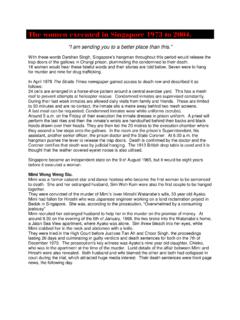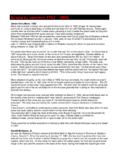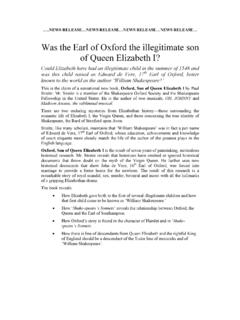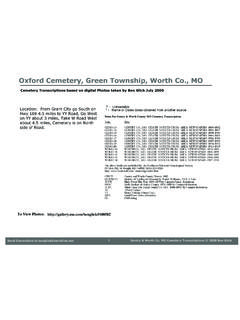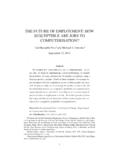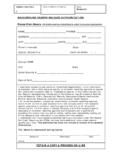Transcription of Oxford Gaol - later HMP Oxford. - Capital …
1 Oxford Gaol - later HMP Oxford . Like some other cities, Oxford found itself with a redundant castle which it turned into a prison in the 14th century, when the military need for castles had passed. After the Civil War the remains of the castle continued to be used as a prison and also administrative and judicial centre. Christ Church College owned the castle at this period and rented it out to jailers who made their living by charging prisoners for their keep. Control passed to the Oxford County Justices and as with most counties in the late 18th century a new prison was constructed, to the design of William Blackburn. This was started in 1786 and gradually expanded during the 19th century. Originally the new building had two wings, one for debtors and the other for felons. The keeper's house was in the centre of the site. A Wing formed the core of the new prison, being a four story structure with large windows.
2 In 1788 two new wings were added, one each for male and female prisoners. The total capacity was 133 inmates. The prison was further enlarged between 1848 and 1856, bringing the capacity up to 218 male and 24 female felons and 133 male and 25 female debtors. A new Governor's House was built outside the walls in 1848. Female inmates ceased to be housed at Oxford after 1924. The prison closed in 1996 and ownership passed to Oxford County Council. The prison was re-developed into the Malmaison Hotel, which opened in 2004. The gallows at Oxford . In the 18th century hangings could take place in the Castle Yard and it is not known whether there was a permanent gallows, prior to 1790. It is known that Mary Blandy was hanged from a beam set between two trees in the Castle Yard in 1752. County executions took place on the Castle Green and on a mound just outside the West Gate of the City.
3 From 1790, until the ending of public hangings the New Drop gallows was erected above the main gate, as was common practice in British prisons. After 1868, when public hanging had been abolished, it was set up in one of the prison's yards just under St. George's Tower. This location was reportedly used for the hanging of Edward Roberts, the first private hanging here, which took place on the 18th of March 1872. William Calcraft was the hangman. Henry Rowles was hanged by William Marwood on the 1st of April 1878 and it was recorded that a pit had been dug beneath the gallows which had been reduced in height to bring the platform nearer to ground level. This enabled Marwood to give a drop of 7. feet 6 inches. The gallows was set up near the Deputy Governor's garden some 40 - 50. yards from the condemned cell and the platform was reached by a short flight of stairs. A new gallows was erected in 1885 for the execution of one Mr.
4 Bodkin, who was later reprieved. This was then sent to Worcester and another new one constructed in a wing of the prison, presumably C Wing, for the execution of Charles Smith on Monday the 9th of May 1887 by James Berry. This was close to the condemned cell but not visible from it. The beam was set in the walls at each end and painted black. It had a an iron band with a ring for attachment of the rope. Beneath were the trap doors that opened into a pit of 10 12 feet in depth. The details of this gallows were reported in Jackson's Oxford Journal newspaper of Saturday the 14th of May. The condemned cell was some 12. yards (36 feet) from the gallows. 63 year old Smith and his wife and family were gypsies, living in a tent at Open Brasenose near Cowley. On the night of Saturday the 19th of February 1887, Smith beat his wife, Lucy, to death with a hammer, whilst the children slept.
5 Just as Berry went to operate the trap, Smith fainted. He had intended to give Smith a drop of four feet. The next hanging at Oxford was that of Joseph Walker on Tuesday the 15th of November 1887. Walker was a saddle maker from Chipping Norton and had also murdered his wife. Berry noted that he was a heavy man at 16 stone (224 lbs.) and gave him a drop of 2. feet 10 inches, the shortest he had ever used. Death was reported as instantaneous. Berry's last execution here was that of Robert Upton on Tuesday the 17th of July 1887. Like Smith, Upton had beaten his wife to death. He had attacked Emma with an iron bar on the 23rd of May 1887 at Milton under Wychwood. Upton was nearly decapitated by the drop and his clothes were saturated with blood. Berry claimed to have given Upton a drop of five feet, but the medical officer, Henry Banks Spencer, thought the drop was nearer seven feet.
6 61 year old Upton weighed 147 lbs and was 5 feet 10 1/2. inches tall with a thin neck. Berry told the subsequent inquest that he had only realised on the gallows that Upton had a degenerative condition of the neck but it was too late at that point to alter the drop length. He had not been able to observe Upton prior to the hanging. James Billington carried out the double execution of 31 year old Charles Raynor and 35. year old Frederick Eggleton on Thursday the 17th of March 1892. They had murdered Joseph Crawley and William Puddiphatt, two gamekeepers, in a wood at Aldbury near Aylesbury. Billington gave Eggleton who weighed 167 lbs, a drop of six feet nine inches and Raynor who weighed 157 lbs, a drop of seven feet. In both cases the LPC4 forms records that there was fracture dislocation of the vertebrae. Billington worked without an assistant at this hanging. Jackson's Oxford Journal newspaper of the 19th of March 1892, reported the executions in detail and stated that the gallows was situated just 15.
7 Yards from the condemned cells. Sometime in the 1920's a new condemned cell was built on A Wing at the junction with C Wing (see sketch). The gallows was in C Wing and at a distance of 40 feet, an unusually long way from the condemned cell. The prisoner was led through a doorway that had been concealed by a wardrobe into the corridor in C Wing to the gallows chamber formed from three cells on the left hand side of the corridor reached via a large square opening (the width of the original central cell of the three knocked together), that replaced the original cell doorway, and later filled in with an expanse of The gallows were permanent. The beam ran square across the chamber from wall to wall, but at 90 degrees to the corridor alignment ( from the inside of the corridor wall, above the doorway across to the inside of the external wall, above the window, along the long axis of the former cell).
8 Presumably the entry to the execution area was usually closed by shutters (similar to Wandsworth, although not as wide). A door in the outer wall of the two ground floor cells, which had been demolished to form the drop room, led out to the yard where burial took place in the in the shadow of the Norman St. George's tower. Here is a simplified diagram of the arrangement. Layout of Oxford prison in later years. Here are unique selection of photos taken by my friend Nick Short of the prison prior to its conversion into a hotel. Oxford Gaol, Administration Block. The small barred doorway in the centre of the picture leads to a spiral stair that emerges at the door to the gallows platform, visible to right of stair tower. Last used 1863 for the execution of Noah Austin. Oxford Gaol, general view of A Wing, top landing of four. Oxford Gaol, A Wing ground floor actually the 2nd level and slightly above ground level, with the lowest level being slightly below ground.
9 Square doorway on right is shower room and condemned cell is the next 2 doorways. Corridor to C Wing and gallows is square doorway beyond these. View of condemned cell from observation post. Another view of condemned cell, with corridor to gallows to left. Just inside corridor, looking towards gallows. Exit door from condemned cell, now bricked up. Looking back down corridor towards condemned cell. Witnesses' door to execution chamber on right, main doorway now bricked up, but where patch of sunlight is. View into execution chamber from witnesses' doorway. Execution chamber. Three cells knocked into one. Low concrete beams for support. Main (blocked) entrance from corridor is patch of brickwork left of centre, with beam socket above it (not visible). Traps were in centre of floor but have been removed and boards laid across drop. Small trapdoor (not original) is for access to pit (used for storage after 1965), but original gallows trap leaf leaning against wall.
10 Blocked window and beam socket above. View into pit. Last used Executions at Oxford . In all 100 confirmed executions were carried out at Oxford between 1735 and 1952, with a further three possible ones in 1742 for which no record of a reprieve has been found. Four women were hanged here in the 1735 to 1766 period, with one more possibly executed in 1742. They were the only women hanged at Oxford . Mary Blandy was the most well known of these. Find a detailed article on her case on the Contents Page and a woodcut picture of her hanging below. List of executions 1735 - 1799. 240 death sentences led to 59 confirmed executions and 3 possible ones. These were carried out on a mound outside the West Gate or on the Castle Green Assize date Name Crime Execution date 1735 - 1737 - No executions 1738 - 1 execution W 1 March William Clifford Burglary M 20 March 1739 - 1 execution W 7 March John Martin Highway robbery M 26 March 1740 & 1741 - No executions 1742 - No confirmed executions but 3 possible where no reprieves have been traced W 10 March Francis Battin Highway robbery Unknown " Elizabeth Cox Sheep theft Unknown " William Harding Sheep theft Unknown 1743 - 2 executions W 2 March John Gale Highway robbery F 25 March " Milly Gray Horse theft F 25 March 1744 & 1745 - No executions 1746 - 2 executions W 5 March Rose Hurle Murder of William Hurle (son) Unknown W 6 August Robert Rowlwright Murder of Rose Rowlwright Fuller W 20 August 1747 & 1748 - No executions 1749 - 1 execution W 12 July Paul Wells jr.
